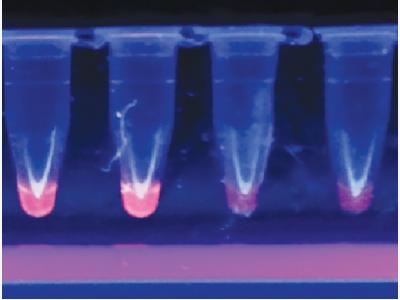On-site diagnostic kit identifies WSSV in shrimp

Loop medicated isothermal amplification (LAMP) identifies target gene of pathogen
A loop mediated isothermal amplification (LAMP) on-site kit.
In field testing, farm staff readily learned how to use the WSSV detection kits.
Global aquaculture production has increased steadily, now producing 90 million metric tons (MT) valued at $144 billion annually and accounting for 42 percent of the total fisheries production, according to the latest data from the Food and Agriculture Organization of the United Nations. With the advance of its production and marketability, aquaculture has become an essential source of food and livelihoods worldwide, especially in developing countries.
Research and development — particularly in the areas of disease management and good aquaculture practices — play a major role in increasing production. Disease outbreaks significantly diminish aquaculture production, especially for medium- and small-scale farmers.
The development of novel ways of biosurveillance will significantly affect the industry’s sustainability. Early detection of target pathogens, for example, can help mitigate the spread of diseases and prevent massive mortalities.
Many new technologies, however, are still out of reach for many farms due to their high prices and the need for a skilled technical staff to implement molecular diagnosis. Most of the available technology is produced by developed countries and tends to be either unavailable to the local market or simply too expensive and highly technical to be utilized by farm personnel.
LAMP technology
Loop mediated isothermal amplification (LAMP) is a DNA amplification technique developed by Tsugunori Notomi and his colleagues from Japan in 2000. The highly specific and rapid amplification technique can amplify DNA in isothermal conditions. Unlike polymerase chain reaction (PCR) methods, which amplifiy DNA by constantly changing temperatures, the LAMP assay uses a single temperature setting during the reaction.
It uses four sets of primers that target six regions of the DNA. It requires a special kind of DNA polymerase, Bst, which has strand displacement activity. The amplification procedure creates stem-loop configurations of the target DNA.
After its introduction, LAMP was used as a diagnostic tool and “point of care” system for different human diseases, as well as in detecting pathogens in aquaculture. LAMP has potential applications for clinical diagnosis, as well as surveillance of infectious diseases in developing countries without requiring sophisticated equipment or skilled personnel. Despite its wide use as a diagnostic tool in the laboratory, its application at the farm level is limited, because the preparation of quality DNA templates is still highly technical, and the cost is high.
On-site WSSV diagnosis
A LAMP-based on-site diagnostic kit, a platform for the rapid detection of white spot syndrome virus (WSSV) designed for the shrimp industry in the Philippines, was developed by a team of researchers from the University of Santo Tomas in Manila, Philippines. The detection tool can amplify the target gene of the pathogen using a single temperature and give results in one hour.
The kit is designed to replace the traditional practice of relying on on-site morphological and physiological observations to determine the occurrence of disease outbreaks. The diagnostic kit includes a locally fabricated heat block that replaces the expensive commercially available equipment. This heat block uses low-cost raw materials in making the machine, which delivers the right balance of effectiveness and simplicity needed in the farm setting. It also includes a sample preparation kit for the LAMP reaction that can extract DNA from the target organ in less than 20 minutes.
The reagents used in the kit are all inexpensive and readily available. The kit also uses simple dye that can be seen under black light to interpret the assay results. This overall approach eliminates the expensive equipment, tedious sample preparation and visualization of results associated with conventional PCR assays.
Field trials
The diagnostic kit was conceived as a farm-based detection platform. During its pilot testing at selected sites in the Philippines, it provided encouraging results with no false positive results.
The DNA isolation part of the kit provided quality DNA that was also validated in the laboratory. The kit also proved more sensitive than PCR in the farm setting. Using the prototype kit, 87 percent of the samples tested positive, while PCR testing identified only 25 percent of the same samples.
The farm personnel performed the procedure with the help of a simple manual and minimal training. They were able to extract the DNA, perform the assay and view results using a hand-held black light.
Perspectives
WSSV occurrence remains a problem for the shrimp industry that causes huge economic losses. As efforts to raise production levels continue, and research interest in aquaculture grows, expansion of the use of biosurveillance methods is also expected.
Beyond the initial testing sytem for WSSV, additional primers for other pathogens in shrimp and fish can be designed using the current diagnostic platform. The technology can then be used by research facilities, universities, government agencies and shrimp farms to become a staple for the detection of WSSV and other infectious diseases in aquaculture in the Philippines and other countries.
Related news
 Limited decomposition enhances PCR detection of AHPND Vibrio in shrimp
Limited decomposition enhances PCR detection of AHPND Vibrio in shrimp Reports have been issued over the past several years regarding the presence of acute hepatopancreatic necrosis disease (AHPND) in various countries
 Probiotics benefit Pacific white shrimp challenged with AHPND
Probiotics benefit Pacific white shrimp challenged with AHPND Early mortality syndrome (EMS) is a management syndrome. A combination of adverse factors in nutrition, biosecurity, host physiology, and especially microbial
 Indoor-raised shrimp find potential market in Kentucky test
Indoor-raised shrimp find potential market in Kentucky test By growing shrimp in a closed building, producers can dramatically increase biosecurity, produce shrimp more consistently, grow shrimp year-round